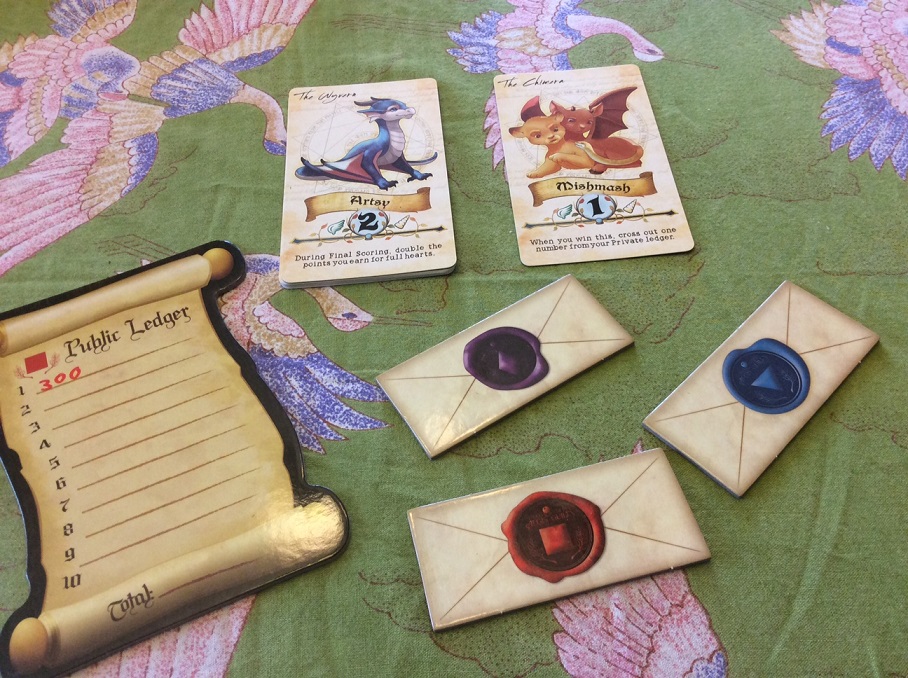Bid on Creatures in Magic Money: A Money-Less Auction Game

Magical creatures are looking for a new home. Bid on as many as you like with as much money as you like. But be careful, because the player who spends the most will be eliminated at the end.
Published by Indie Boards & Cards, in Magic Money players can bid any amount that they can imagine from one to a zillion. Winning bid amounts are public knowledge but the losing bids are kept secret until the end of the game.
Gameplay
Shuffle the creature deck and place it face-up on the table. You then draw the top card and set it in the center, which is the card that is up for bid. Each player takes a ledger board—one side is public and the other is kept secret. Everyone also takes a bidding token.
In the first round, the active player picks any positive, whole number he wants as his bid on the creature, and writes the number down on the public side of his ledger. In subsequent rounds, the active player is whoever won the previous bid, and his bid must always be one tenth of the previous winning bid (this is calculated by simply removing the last digit from that bid, although the bid can never be lower than one). All other players then secretly write their bids on their bidding tokens and pass them to the active player. Players may bid any amount they can think of. You have limitless income.
The active player looks at the bidding tokens, and announces the winner and the amount. The winner writes down his winning bid on the public side of his ledger, while the losers write down their bids on the secret side of their ledgers. The winner then moves the creature in front of himself, and a new creature is drawn for the next round.
Each creature card shows the number of points it is worth and can have one or more attributes marked on it. Attributes score in different ways at the end of the game. You score one point for each horn attribute on your creature cards, but only if you have an odd number of them. For wings, you score one point for each player with fewer wings than you. There are also left and right sides of hearts. You score two points for every set (one of each side) that you collect. Some creatures also have special abilities such as allowing a player to mark a bid off their ledger or giving them a wild to count towards attributes at the end of the game.
Once the last creature has been won, all players count up their points. However, all players must also tally how much they spent both on the public side of their ledger and on their secret side. The player who spent the most money is eliminated from the game. Whoever is still in the game and has the most points, wins.

Review
The idea of taking resource management out of an auction game is quite clever, and there is something refreshing about just enjoying the auction and guessing what opponents are doing and where they are with their spending, without actually tracking how much money you still have and how much you’re going to need on future rounds. It keeps the gameplay quite streamlined, and adds a fun element to the player interaction.
One interesting aspect of the game is figuring out the economy the group is playing in. Are people making two digit bids? Three digit bids? Four? This develops over several rounds and is interesting to watch develop and see how each player affects it.
You also need to consider which cards are going to be most valuable for whom. Both the scoring and the attributes on the creature cards need to be taken into account. The attributes can play a significant role in scoring you extra points, without taking over the whole game, so there’s plenty to consider there, as well as in the special abilities. It is also a nice touch that you can always see the card that will be up for auction next round. If you know you’re going all out next time to win a card, you can make a more conservative bid this round.
The game is best played with five to six players, as the more hidden information, the more unpredictable the bids are going to be and the more suspense in guessing whether you’ll be knocked out of the game at the end. The game does say it can be played with three, but it really defeats the core mechanism that drives the heart of the game as there is very little hidden information. Only one player ends up missing one piece of information each round, making it a lot easier to track where everyone is at in spending.
Magic Money’s production quality is quite nice. The ledger boards are nice and solid, the bidding tokens thick, and the artwork on the creature cards is both adorable and creative.
This is a really solid auction game. It’s a lot more about the other players and guessing what they’re doing, and it plays well with a large group. Its rules are quite streamlined, while the scoring ensures there’s something to weigh, other than your opponents, when making your bids.
Pros: Player interaction, ability to bid any amount, production quality
Cons: Not good with three players
Note: Some might question the similarity between Magic Money another game, Q.E. — while both were developed in parallel, we prefer Magic Money due to the richer theme and simpler scoring mechanisms.
Disclosure: we received a complimentary review copy of this game.







